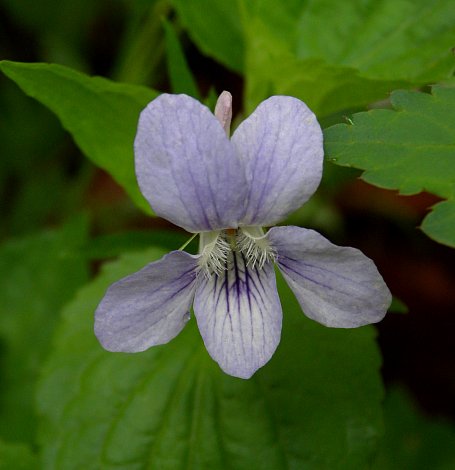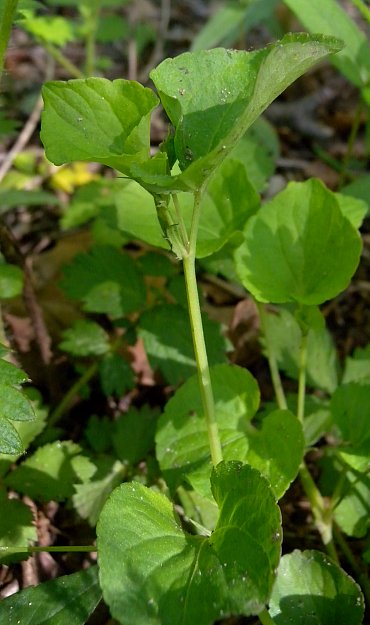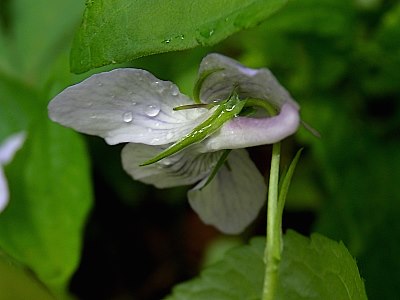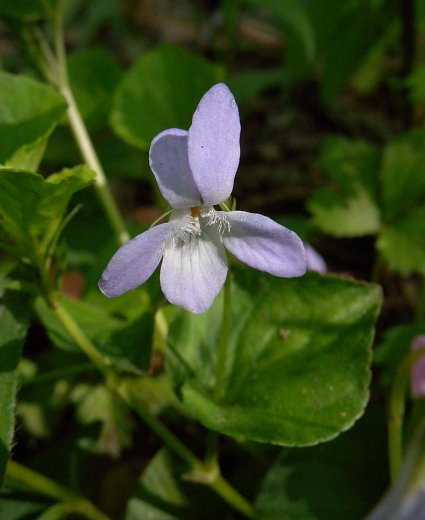Description: This perennial wildflower is 4-8" in length (or longer), consisting of leafy stems with axillary flowers and seed capsules. The stems are light green and glabrous. The blades of alternate leaves are about 1-2½" long and ¾-1½" across; they are oval-cordate in shape and serrate-crenate along their margins. The base of each leaf blade is indented, while its tip is well-rounded to somewhat pointed. The upper blade surface is medium to dark green and glabrous, while the lower surface to light to medium green and glabrous. The slender petioles are about the same length as the leaf blades or shorter; they are light green and glabrous. At the base of each petiole, there is a pair of stipules up to ½" long. These stipules are linear-lanceolate in shape and coarsely toothed along their margins. Individual flowers develop from the axils of the leaves on slender pedicels about 1½-3" long; the flowers are usually held above the leaves. The pedicels are light green and glabrous; there is a pair of small linear bracts toward the middle of each pedicel.

Individual flowers are ½-¾" across, consisting of 5 pale blue-violet petals, 5 green sepals, and the reproductive organs. The style of each flower is bent downward at its tip, where it is not swollen. Dark blue-violet veins radiate away from the throat of each flower across the petals; the two lateral petals have tufts of white hair (or beards) toward their bases. The lower petal has a relatively long nectar spur about ¼" long; this spur is sometimes visible when the flower is viewed from the front (behind the upper 2 petals). The nectar spur is relatively stout and either straight or slightly hooked. The sepals are linear-lanceolate, sometimes toothed toward their bases, and hairless. The blooming period occurs during the middle of spring for about 1 month. Fertilized flowers produce an ovoid-oblongoid seed capsule about 1/3" long. This capsule splits open into 3 parts to fling the seeds from the mother plant. This wildflower also produces inconspicuous cleistogamous flowers during the summer, which are self-fertile; their seed capsules are similar to the earlier fertilized flowers. The small seeds are globoid in shape and light brown at maturity. The root system consists of a vertical crown with fibrous roots and horizontal rhizomes; clonal offsets are produced occasionally from the rhizomes.

Cultivation:
During
the spring, the preference is dappled sunlight to light shade, moist
conditions, and a rich loamy soil with abundant organic material. Later
in the year, more shade is tolerated.
Range & Habitat:
The native Dog Violet is found primarily in NE Illinois (see Distribution
Map). This wildflower is considered rare and it is
state-listed as 'threatened.' Habitats include moist rich woodlands,
swampy woodlands, and moist meadows in wooded areas. Sometimes this
violet is found in slightly sandy habitats that are similar to the
preceding ones. Dominant canopy trees in these habitats are typically
ash, maple, or elm. Dog Violet is found in higher quality habitats
where the original ground flora is still intact.

Faunal Associations: In this section, information about floral-faunal relationships applies to Viola spp. (Violets) in general. The flowers of violets are cross-pollinated primarily by various bees, including honeybees, bumblebees, Mason bees (Osmia spp.), Little Carpenter bees (Ceratina spp.), digger bees (Synhalonia spp.), Halictid bees, and Andrenid bees. One bee species, Andrena violae (Violet Andrenid Bee), is a specialist pollinator of violets. Other floral visitors include bee flies (Bombylius spp.), small butterflies, skippers, and ants. Most of these insects suck nectar from the flowers, although some of the bees also collect pollen. Other insects feed on the foliage and other parts of violets. These insect feeders include the caterpillars of several Fritillary butterflies (Euptoieta claudia, Boloria spp., Speyeria spp.) and the caterpillars of several moths, including Elaphria grata (Grateful Midget), Eubaphe mendica (The Beggar), and Apantesis nais (Nais Tiger Moth). Other insect feeders include the thrips Odontothrips pictipennis, the aphid Neotoxoptera violae, and the larvae of Ametastegia pallipes (Violet Sawfly). Vertebrate animals feed on violets only to a limited extent. The White-Tailed Deer, Cottontail Rabbit, and Wood Turtle (Clemmys insculpta) sometimes browse on the foliage, while the White-Footed Mouse eats the seeds. Birds that feed on violets include the Mourning Dove (seeds), Ruffed Grouse (seed capsules, foliage), and Wild Turkey (seed capsules, rhizomes).

Photographic
Location:
A damp area of Goll Woods in NW Ohio, and a swampy woodland at the
Indiana Dunes National Lakeshore in NW Indiana.
Comments:
This interesting species belongs to a small group of violets with
blue-violet flowers, nectar spurs of above average length, and
flowering leafy stems (as opposed to violets with basal leaves and
flowers on separate non-leafy stalks). Aside from the Dog Violet, other
species in this group include Viola labradorica
(Alpine Violet), Viola adunca (Hook-Spurred
Violet), and Viola walteri (Walter's Violet). While
the Dog Violet has pale blue-violet flowers, these other violets often
have medium to dark blue-violet flowers (among other minor
differences). The Alpine Violet and Hook-Spurred Violet have a more
northern boreal distribution, while Walter's Violet is more southern
and Appalachian. None of these three species have been found in
Illinois. Some authorities have proposed reducing the status of the Dog
Violet to a variety of either the Alpine Violet or the Hook-Spurred
Violet.